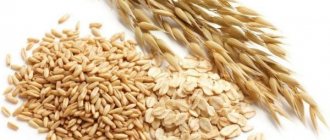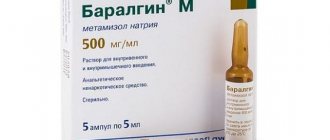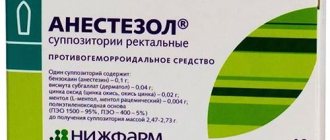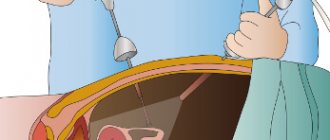Fear of appendicitis
The feeling of fear is a natural human defensive reaction that helps to avoid dangerous life situations. Fear is a bad advisor for diseases accompanied by pain. Pain is a signal that the body has stopped coping with an internal problem on its own. Abdominal colic that does not subside for 3-4 hours is a sign of the seriousness of the health problem and one of the symptoms of appendicitis, as well as a reason for an urgent visit to a medical facility.
The causes of pain are always associated with:
- irritation of nerve endings by inflammatory products;
- compression (spasms), stretching and injury to nerve fibers.
Physical pain can usually be controlled with pharmaceutical medications. However, without complex treatment, and sometimes radical surgery, it is impossible to stop the pathological process - inflammation of the appendix. If the focus of the disease remains, the pain will return sooner or later.
Other phobias (according to patient surveys) are associated with fears:
- trusting your life to surgeons;
- unfavorable outcome of the operation;
- long-term consequences;
- correct diagnosis.
With regard to the first three phobias, fears are justified to some extent, but later contact with a medical institution only increases the risks. The operation turns from a routine procedure into a complex manipulation.
As for doubts about the correctness of the diagnosis, indeed, the signs of appendicitis do not always correspond to the descriptions in the medical literature, and symptoms characteristic of appendicitis may be a manifestation of other dangerous diseases, for example:
- diseases of the gastrointestinal tract - these are stomach ulcers, duodenal ulcers, blockage of the small intestine, Meckel's diverticulum (a blind outgrowth of the intestine, similar in appearance to the appendix), appendiceal infiltration, periappendiceal abscess, cancer or perforation of the intestine, pancreatitis, cholecystitis;
- diseases of the genitourinary system - inflammation or obstruction of the ureters, inflammation of the appendages, pathological spasms during ovulatory cycles;
- infectious diseases - typhoid fever, dysentery and others.
Many casuistic diseases are disguised as appendicitis. Diagnostic errors do occur, but they are rarely fatal for the patient. With the introduction of laparoscopy into practice, the number of errors has decreased significantly.
Phobias associated with the peculiarities of the patient’s physiological state and the difficulty of diagnosis during this period, namely:
- pregnancy is a natural fear for the life of the fetus, which is combined with a distorted clinical picture due to compression of internal organs;
- old age – combined with the accumulation of various chronic diseases;
- childhood - for obvious reasons, phobias are typical for parents with exaggerated fears for the health of their child.
Modern diagnostic equipment and surgical technologies make it possible to find optimal, safe treatment suitable for each specific case at any age and in any physiological condition.
Appendectomy. Depending on the clinical situation, the operation is performed urgently or as planned.
Emergency surgery. The indication is the acute stage or exacerbation of chronic inflammation. The operation is performed two to four hours after the patient enters the clinic. The urgency is due to the rapid development of a dangerous condition (peritonitis, perforation of the walls of the appendix, outpouring of pus into the abdominal cavity).
Planned surgery. If emergency intervention is prohibited, the operation is carried out after the threats have been eliminated. The time for the planned operation is determined based on the timing of palliative (threat-removing) treatment and recovery.
Preoperative period for appendicitis
An appendectomy is classified as an emergency operation, so all necessary procedures in the emergency room are performed as quickly as possible.
Patient registration
Patient registration is a mandatory condition for staying in a medical institution. To speed things up, prepare the necessary documents in advance:
- passport of a citizen of the Russian Federation or a document replacing it (military ID);
- health insurance policy (compulsory or voluntary);
- individual personal account insurance number card (SNILS);
- outpatient card, if available (usually it is located in the clinic at the place of residence, but sometimes it is issued in person).
Some problems with obtaining free appendix removal may arise for persons who do not have citizenship of our country.
This does not mean that they will be denied emergency assistance, however, to eliminate the problem, they should obtain a compulsory medical insurance (compulsory health insurance) policy in advance. To obtain a policy, contact the nearest insurance company that has a good business reputation in the insurance market. The policy in the form of a plastic card takes a month to produce, and a temporary policy is issued on the day of application.
Attention! Foreign citizens temporarily or permanently residing in the Russian Federation are issued a compulsory medical insurance policy on the basis of Art. 10 of the Federal Law of the Russian Federation of November 29, 2010 N 326-FZ.
The presence of a temporary or permanent compulsory medical insurance policy is mandatory for all categories of citizens admitted to a medical institution.
Additionally you must present:
- for a refugee - a refugee certificate or a copy of the application for this status (complaints regarding its deprivation);
- for a stateless person temporarily residing in the territory of our country - an identity card with a note indicating permission to stay in the Russian Federation.
- for a foreign citizen temporarily staying in our country - a passport of the citizen’s country of residence with a mark from the migration service of the Russian Federation about temporary permission to stay in our country.
- for a foreign citizen permanently residing in our country - a passport of a foreign state and a residence permit in the Russian Federation.
The problem will be greatly simplified by contacting a clinic that provides paid services, including through voluntary health insurance (VHI).
Diagnosis of appendicitis
It is performed by a surgeon in a limited time period.
Indications for surgery may be the results of a clinical examination with clear symptoms of an “acute abdomen” without confirmation of the source of pathology in the appendix. This strategy is completely justified, since in addition to appendicitis, the causes of emergency surgical intervention are diseases of the abdominal organs similar to appendicitis. During the operation, after examining the intestines and abdominal organs, the treatment tactics can be adjusted by the surgeon.
Sequence of diagnostic procedures:
- Patient interview;
- Examination: general - pay attention to the patient’s posture, his gait, local - the condition of the abdominal wall (increase, decrease, symmetry of the sides);
- Palpation (palpation) - pay attention to pain at the site of application of force, and also take pain tests and use internal palpation - rectal, vaginal;
- Percussion (tapping) – used to identify pain and tactile (touch) sensitivity;
- Laboratory blood tests - counting the number of leukocytes, determining the ratio of different types of leukocytes in a stained smear and erythrocyte sedimentation rate, urine - general analysis. If indicated, other studies may be included, for example, pregnancy testing in women. Unfortunately, standard laboratory tests show only a general picture characteristic of inflammation.
- Instrumental methods - plain radiography of the abdomen, radiography or computed tomography with contrast, ultrasound and its modifications.
- Differential diagnosis. If the clinical picture is unclear, mild and there are no clear indications for emergency appendectomy, the diagnosis continues until the reasons are clarified. Laparoscopy is most often used as a method of differential diagnosis.
During the preparation for surgery, the anesthesiologist conducts a study of the cardiovascular system and collects an allergy history in case of intolerance to pharmacological drugs for anesthesia.
If necessary, an intravenous drip infusion of an isotonic solution is carried out in order to maintain tone, relieve intoxication and prevent dehydration, as well as placing a tube in the stomach to evacuate the contents.
Due to the varying severity of the clinical condition of patients admitted for surgery, the sequence of diagnostic studies may partially change.
Preparing the surgical field for appendicitis
Preparation includes treating the abdominal skin, shaving areas of hair, degreasing and disinfecting the skin in the area of the surgical field.
If before the operation it becomes known that the patient is allergic to solutions for skin disinfection, chemicals and drugs, the anesthesiologist adjusts his actions.
Scar Treatment Options
Worrying about the appearance of the scar immediately after surgery is a waste of time. Over time, the scar will smooth out and fade. If you are concerned about the appearance of an ugly scar, then pay attention to correction methods.
Tattoo
A tattoo on an appendicitis scar is a popular solution to disguise the scar. The tattoo is applied a year after the operation. The price of the work depends on the complexity of the design, the experience of the artist and the salon where the tattoo is done.
Tattoo on a girl's appendicitis scar, photo
We recommend that you contact only trusted salons and use the services of experienced professionals who comply with hygiene standards in their work.
Ointments and gels
Pharmacies sell ointments, gels and antiseptics for the treatment and correction of sutures. They soften the density of fibrous tissue and make the scar smaller. In addition, pharmaceutical preparations change the color of the scar from red to flesh-colored.
Don't forget to ask your doctor which products are right for you. There are contraindications due to allergies to components.
Physiotherapy
When treating a scar with physiotherapy, the following is used:
- Electrophoresis.
- Ultrasound.
- Magnetotherapy.
With these procedures, drugs are introduced into the patient's skin that:
- dissolve fibrin (the basis of the scar);
- stimulate tissue healing;
- soften and smooth the top layer of keratinized skin.
Ultrasound is most often used, because it improves the permeability of the skin to drugs. The session lasts on average 5 minutes. The duration of the course is 10 procedures.
Before taking hormonal medications, you need to visit a doctor. If not treated properly, drugs are harmful to health.
Treatment is carried out through local injections directly into the scar tissue. If necessary, an anesthetic - lidocaine or liquid nitrogen - is injected into the skin near the scar.
Treatment of appendicitis scar with hormonal drugs
Hormonal therapy is effective against severe, overgrown scars - keloid and hypertrophic. And also to stop adhesions. Side effects from therapy include hyperpigmentation, swelling, seoporosis and gastric ulcers.
Chemical peeling
The main substance of peeling is acids, which destroy the top layer of skin. After peeling, the skin is treated with special preparations to moisturize and nourish.
A month later the procedure is repeated. The course lasts 3–4 procedures. Deep peeling is contraindicated for people with dark skin because it lightens the top layer.
Laser resurfacing
Contraindicated in pregnancy, infections and fresh wounds. Laser resurfacing is carried out six months after the operation. For the effect, 5-6 procedures are required with an interval of a week to a month (depending on the area of the scar).
We suggest you read: There is a red spot on the tip of the tongue and it hurts
After a course of grinding, recovery lasts for a week. At this time, the skin peels off. It is recommended to avoid the sun, not wear synthetics and use healing ointments.
Plastic
An expensive option with a 100% guarantee of effect. It involves transplanting the top layer of skin to the site of the scar.
Operating period for appendicitis
Before the operation, at the request of the patient and his loved ones accompanying him, it is possible to conduct a conversation about the upcoming manipulation, providing information about the essence of the operation, methods of pain relief and possible complications. But since the operation is an emergency, this conversation is sometimes not carried out.
The operating period includes:
- introducing the patient into a state of anesthesia;
- layer-by-layer dissection of the abdominal wall;
- inspection of the abdominal cavity and the organs located in it, examination of the appendix and part of the intestine (approximately 50 cm before and the same amount after its origin);
- resection of the appendix, suturing the edges of the removed appendix;
- tightening and suturing of the peritoneum with absorbable threads (sutures are not removed);
- tightening the skin and applying interrupted (removable) sutures.
If there are complications (outpouring of the contents of the appendix into the abdominal cavity), the cavity is sanitized and temporary drainage is secured in order to evacuate the products of inflammation outside the body. This drainage is removed before the surgical skin sutures are removed, immediately after the body’s condition has stabilized.
Time of operation. There are no standards; it can last from 40 minutes to 2-3 hours, depending on the severity of the pathogenesis, physique, age of the patient, location of the appendix in the abdominal cavity and many other factors.
Anesthesia is an important stage of the operation. The quality of pain relief determines the operation time, the speed of healing of the surgical wound, and the likelihood of surgical and postoperative complications.
When removing the appendix, three options for pain relief are used:
- tight infiltration method;
- conduction blockade;
- general anesthesia.
All methods, when performed correctly, have an adequate analgesic effect. The first two methods require the person being operated on to be conscious during the operation; therefore, they are contraindicated for:
- young children - uncontrollable anxiety of a small child interferes with appendectomy;
- patients with peritonitis - extensive surgery involves sanitation of the intestines, which may result in reflexive tension in the muscles of the abdominal wall;
- patients undergoing laparoscopic surgery - manipulations inside the abdominal cavity with a medical instrument in a conscious person cause a gag reflex and spasm of the abdominal wall muscles, and muscle relaxants are not used to suppress these phenomena without general anesthesia with controlled ventilation.
- patients with increased excitability, individual intolerance to novocaine and its derivatives.
Although considered outdated, local anesthesia techniques have proven to be effective and safe when performed skillfully.
Tight creeping infiltration method
Target
– ensure painless layer-by-layer cutting and suturing of the skin and abdominal wall.
The pain sensitivity threshold of the intestine is much lower; to relieve pain, a solution of novocaine is periodically added to the abdominal cavity, or other drugs are used.
Principle of the method
– layer-by-layer under pressure created by a syringe, impregnation of layers of skin, muscles and tissue of the abdominal wall with a 0.25% solution of novocaine. As a result of injection of the solution under pressure, an extensive novocaine layer is created under the surgical field, blocking the conduction of pain impulses. During the operation, you have to constantly repeat this procedure.
Practical value
lies in the simplicity of execution and the ability to control the basic physiological indicators of the patient being operated on without complex medical equipment. The operation can be successfully performed under primitive conditions.
Flaws
– novocaine does not relieve the gag reflex; During the operation, you have to constantly inject a solution of novocaine.
Regional or regional anesthesia
The purpose is similar to that of the creeping infiltration method. The principle is based on blocking the conduction of nerve impulses through the nerve bundles innervating the intestines by introducing painkillers into the space surrounding the nerve ganglion from which the nerve bundles diverge. The technique is complex compared to tight infiltration. The anesthesiologist is required to have good knowledge of the topographical landmarks of the needle insertion site and the location of the nerve ganglia.
Solutions of different concentrations (bupivacaine, lidocaine, ropivacaine) are used as anesthetics.
Advantages of the method:
- speed of onset of effect;
- small doses of pain medication;
- reliable anesthesia, no need to constantly add anesthetic;
- the possibility of combining different techniques.
The disadvantage is the difficulty of implementation.
General anesthesia is a modern method of pain relief
The patient is put to sleep and brought out of general anesthesia in stages. During the narcotic state, the anesthesiologist controls the cardiovascular and respiratory systems of the patient being operated on.
The stages of anesthesia consist of premedication, administration of drugs, anesthesia itself and recovery from this state:
- Premedication. The goals are to increase the body’s resistance before surgery, to ensure stable functioning of the heart and lungs during the operation;
- Introductory anesthesia or induction. The goals are to gradually bring the operated patient to a state of anesthesia, to adapt the heart and breathing to the conditions of anesthesia. At this time, if necessary, muscle relaxants are administered and tracheal intubation is performed for artificial ventilation. The duration of the period is 10-15 minutes;
- Maintaining anesthesia. The goals are to maintain a stable level of basic body functions and the absence of pain sensitivity. The duration of the period corresponds to the operation time. During the operation, fractional addition of drugs is allowed;
- Recovery from anesthesia. The goals are the removal of anesthesia metabolites, restoration of vital functions and the transition of the body to independent functioning.
Potent restricted pharmaceuticals are used as drugs for general anesthesia during appendectomy.
Possible complications of this stage are monitored by an anesthesiologist. The risk group includes patients with hypersensitivity and concomitant diseases that weaken the functioning of the heart and respiratory system.
Layer-by-layer dissection of the abdominal wall for appendicitis
General principles for making an incision in the abdominal wall:
- The incision is made layer by layer. This allows you to control the process and, if necessary, alloy blood vessels in a timely manner, which reduces the risk of injury to muscles and aponeuroses;
- The length of the incision is not strictly regulated; it must be sufficient for the surgeon’s work. An incision that is too small creates problems during the extraction and revision of internal organs, and the reduction of the omentum and intestinal loops into the abdominal cavity, while an incision that is too large increases the time of tissue suturing and aggravates the risks during the wound healing period;
- The muscles, aponeuroses and omentum are separated using a blunt method, that is, a small puncture is made, and then they are separated along the fibers with tools and hands.
At this stage, bleeding that is not noticed when the blood vessels of the abdominal wall is disconnected is dangerous. With insufficient pain relief, intra-abdominal pressure reflexively increases, and uncontrolled prolapse of the omentum and intestinal loops is possible. All these risks are taken into account by the surgeon.
Revision of the abdominal cavity for appendicitis
After disconnecting the abdominal wall, the omentum is moved back and the internal organs are examined. If necessary, intestinal loops are removed outside the abdomen. At the same time, an inflamed appendix is found.
When examining the appendix, internal organs and intestinal loops, attention is paid to visible morphological defects in the walls of the peritoneum and the organs being examined. When changes are detected, the surgeon acts in accordance with the instructions and his own intuition. With uncomplicated appendicitis, the operation enters the final stage. In case of complications, the algorithm of actions is different.
When examining internal organs under local anesthesia, one should be wary of the gag reflex in response to tightening of intestinal loops. The danger lies in uncontrolled prolapse of intestinal loops, spontaneous rupture of the appendix and infection of the abdominal cavity. These risks are taken into account by the surgeon and anesthesiologist.
Appendix resection
The appendix is pulled to the edge of the surgical wound and removed beyond it. Isolation of the appendix from the abdominal cavity is ensured; the technique is described in detail in textbooks and manuals. Catgut or synthetic self-absorbing threads are used as suture material.
The principle of applying a submersible purse-string suture to the stump of the appendix is to tighten the appendix so that the edges of the wound are immersed inside the stump, and the outer side of the appendix is connected by serous membranes to the center. This method of suturing allows you to expect the fastest possible healing and sealing of the appendix.
Risks are associated with possible contamination of the abdominal cavity, instruments and surgical linen due to inaccurate tissue separation, as well as failure of surgical sutures and knots.
Stitching the surgical wound after appendectomy
The connection of the abdominal wall is made with threads that dissolve after some time, and the skin is sutured with interrupted sutures (on average, 7-10 stitches are performed). Strong silk or synthetic threads are used as suture material. The sutures on the skin are removed after 7-10 days. Possible risks are associated with rupture of threads and knots.
Find out more: What can and cannot be done after appendicitis surgery?
Choosing the best master
It is advisable to entrust a tattoo on a scar to a master who already has experience in such work. You should show him the scar and listen to recommendations. If they coincide with the doctor’s advice, this most likely confirms qualifications. To get the truly expected result, you should:
- Choose a quality salon, rather than going to dubious basement organizations.
- Inquire about the availability of permits and the safety of the materials used. A professional must use a set of modern means to ensure sterility, use exclusively disposable needles, gloves, and trays for mixing paints.
- Study photos and works of the master.
- Read reviews on the Internet.
It would also be a good idea to ask the master what style he works in. A highly qualified specialist can make a drawing in different directions, but has his own preferences. It is better that the tastes of the master and the customer coincide.
Postoperative period
The recovery period lasts from the end of the operation until the removal of the sutures on the skin. The duration of the period increases with complex appendectomy. The sequence of actions of medical staff for uncomplicated appendicitis is quite simple.
In the early postoperative period (first day):
- carry out (if necessary) detoxification of the patient’s body;
- Monitor for signs of possible postoperative bleeding, bowel and/or bladder paresis.
In the middle and late postoperative period (on the second – tenth day):
- monitor the restoration of the functions of the patient’s physiological functions (defecation, urination), and take measures if necessary;
- monitor the possible development of postoperative complications (control of body temperature, appetite, condition of postoperative sutures, presence of pain).
How long do they stay in the hospital after appendicitis removal?
After an uncomplicated operation, the patient remains in the hospital for no more than ten days. You can get up after surgery with your doctor’s permission, usually on the third or fourth day (individual recommendation!). To prevent stitches from coming apart, you should sometimes wear a bandage or wrap a towel around your stomach. On the first day after surgery, you are given fluids. From the second day, nutrition is indicated according to the diet recommended by a nutritionist.
Inform your doctor in a timely manner if:
- inability to defecate and/or urinate without straining;
- pain in the abdomen and in the suture area;
- Wetting of the seams and discomfort when moving.
When are stitches removed after appendectomy?
They are removed after the surgical wound is filled with healthy granulation (crust). Under normal conditions, this is the seventh, sometimes tenth day. Sutures are removed in the treatment room. The patient is discharged only after the stitches are removed. Attention! For several days after discharge from the hospital, you should be careful with physical stress - even a well-healed surgical wound may have its edges separated.
What to do if the suture breaks after appendicitis removal?
The reason is non-compliance with the regimen after discharge from the hospital. Both internal and external seams can come apart.
1. A rupture of internal sutures (on the abdominal wall) can be determined by the following signs:
- protrusion (hernia) of the skin in the area of the surgical wound, without compromising the integrity of the skin;
- when you lightly press the place of protrusion of the abdominal wall, you feel a jelly-like or slightly harder formation - this is the omentum;
- pain that provokes vomiting is a sign of intestinal loops protruding under the skin, but usually the omentum prevents intestinal prolapse.
Patient actions:
- Call an ambulance;
- Take a horizontal position on a hard surface;
- If, after taking a horizontal position, the protrusion goes inward, tie a towel around your stomach;
- Calmly wait for the doctor: anxiety and straining only aggravate the dehiscence of the wound.
2. The divergence of external (skin) sutures can be determined by the following signs:
- at the site of the rupture there is a gaping red (scarlet) wound - this is the abdominal wall, there is a suture on it that prevents intestinal prolapse;
- the wound site is bleeding, or the wound is dry.
Patient actions:
- Take a horizontal position, call an ambulance;
- Cover the wound with a sterile napkin; do not put pressure on it, unlike the situation with divergence of internal sutures.
Related article: diet after appendicitis surgery
Which ones can't you hit?
Some scars cannot be hidden under tattoos. This applies to:
- Keloid scars. These scars have a dense structure and a bumpy surface. They have a pink or violet-bluish color, and quite often cause discomfort to a person - they itch and cause a feeling of skin irritation. The risk of keloid scars depends on genetic predisposition; they can occur even as a result of fairly simple injuries. It is impossible to hide such scars under a tattoo, since the impact of the machine and subcutaneous injection of ink can be complicated by the development of new scar tissue, and the tattoo itself can become an unsightly stain on the body.
- Hypertrophic scars. These scars protrude above the skin level and are dark in color. Most often they appear on the body after serious injuries, burns and difficult surgical interventions. Tattoos on them are most often left unmarked, since such a procedure can lead to the formation of new scar tissue, and can also be complicated by the accumulation of significant pigment under the skin. However, exceptions are possible - in some cases, a tattoo can be made on a hypertrophic scar.
Only a doctor can determine how safe a skin scar is. Sometimes doctors allow you to get a tattoo even on a hypertrophic scar, but you must wait until it is completely formed.
Complications after appendectomy
Complications after appendectomy are divided into early and late. We will focus on the main manifestations of complications that sometimes bother patients after removal of the appendix.
Fever after appendicitis surgery
Low-grade fever is a frequent companion to inflammation of the appendix and one of the symptoms of the disease. An increase in temperature is a signal of the presence of a focus of inflammation. At the first stage of the disease, this is a useful signal - it means the body is resisting. A short-term increase in temperature after removal of appendicitis is not dangerous and goes away on its own or after several treatment procedures.
Hyperthermia after removal of appendicitis (within a month) is dangerous if it occurs against the background of:
- vomiting;
- constipation or diarrhea;
- pain in the abdomen;
- disturbances of consciousness;
- increased sweating.
In some cases, the temperature after removal of appendicitis lasts for a very long time, sometimes up to three to six months. In this case, it is necessary to conduct an in-depth examination. Perhaps the reason is a reflex violation of thermoregulation.
Pain after appendicitis surgery
Pain is the result of inflammation of the sutures, the formation of adhesions or incipient peritonitis. It is possible that pain may persist from concomitant pathology that was not eliminated during appendectomy.
You need to contact a surgeon at the clinic at your place of residence, or the surgeon who performed the operation.
Adhesions after appendicitis surgery
Adhesions are fibrous tissue, the result of adhesive inflammation. They lead to a connection between the serous membranes of different intestinal loops. The causes of adhesive inflammation are unpredictable; sometimes the pathology is provoked by microorganisms that enter the abdominal cavity during surgery, but it is believed that adhesions occur in sedentary people, as well as in old age.
Adhesions formed on the intestines after appendicitis manifest themselves as increased pain when the intestines are full of food and gases, as well as when peristaltic contractions of the intestines increase. It is difficult to treat adhesions, since the fibrous tissue of the adhesions is penetrated by blood vessels and nerves.
Peritonitis after appendicitis
Peritonitis occurs as a result of perforation of the appendix. Accordingly, the operation to remove appendicitis is carried out taking into account the severity of the pathogenesis, while the intestines are sanitized, drainage is applied, a constant outflow of inflammatory exudate is maintained and complex treatment is prescribed in the postoperative period.
Peritonitis after appendectomy is a phenomenon predicted in persons:
- elderly;
- with chronic pathologies;
- with a history of severe preoperative condition.
Symptoms of peritonitis are high temperature, pain and hardness of the abdominal wall, large-scale intoxication.
Postoperative hernia after appendicitis
An incisional hernia is the result of a rupture of the abdominal wall at the site of the surgical incision some time after the operation. A hernia is the result of a combination of the following factors: poor fusion of the edges of the surgical wound, severe straining or blunt trauma to the abdomen in the area of the surgical wound. It manifests itself as a protrusion of the abdominal wall at the site of the postoperative suture. The actions of a person who has a hernia after appendicitis are similar to those recommended for patients with internal suture dehiscence (see above).
Causes of pain
Unpleasant sensations and pain at the suture site can occur after any surgical intervention. The nerve fibers of the soft tissues are damaged, and the sensitivity of the injured part of the body increases. This process is natural and understandable - damaged tissues grow together, sutures heal.
But if over time the pain only intensifies, and the temperature periodically rises, this is a reason to seek help. Internal tissue suppuration may occur even if the external incision is closed.
Why does the suture hurt after surgery and how long will it take to heal? This directly depends on the complexity and duration of the operation, the qualifications of the surgeon, and the cleanliness of the instruments and materials used. Pain may occur for the following reasons:
- the seam area has been rubbed by clothing;
- formation of adhesions, hernias;
- inflammation at the site of the ligature - the body rejects the threads;
- divergence of internal seams due to muscle tension;
- aching pain, as a reaction to a sudden change in weather conditions.











